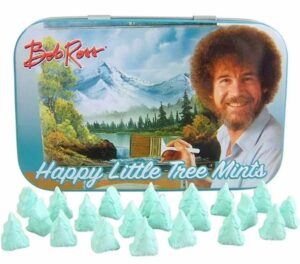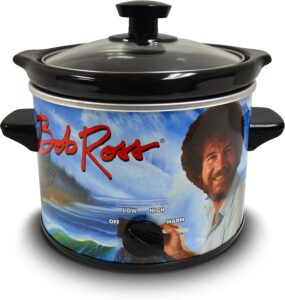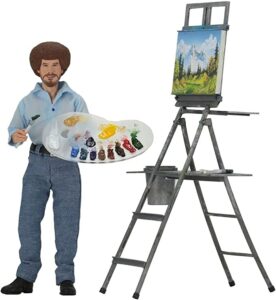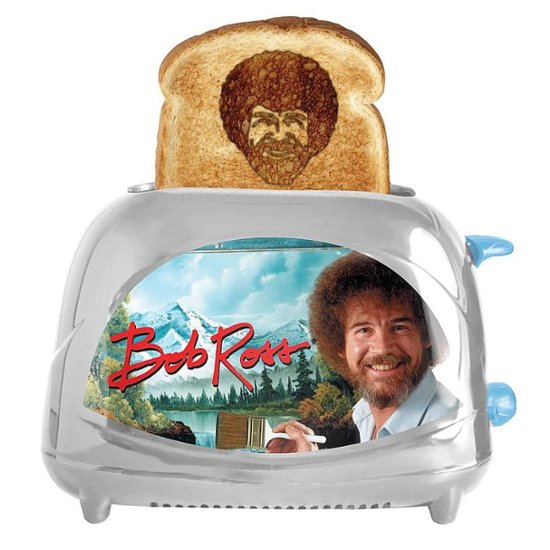
Bob Ross’ The Joy of Painting first appeared on PBS when I was 24 years old. At one time, his show was PBS’ most popular offering ever, but that was lost on me. We didn’t own a television set during the eleven years he broadcasted.
That is not to say that I didn’t recognize his gentle voice, his fabulous perm, or his Happy Little Trees. The mesmerizing dullness of his show was wildly popular among my stoner friends. I had a Bob Ross contact high, understanding his cultural significance without watching the show.

Ross can be forgiven for making 20th century sofa art. His art was secondary to his career in the Air Force, where he rose to the rank of Master Sergeant. He took classes at the Anchorage, Alaska USO at a time when Abstraction reigned. His teachers wanted nothing to do with representational painting. “They’d tell you what makes a tree, but they wouldn’t tell you how to paint a tree,” he recollected. I felt his pain; I was learning to paint at the same time.
After the Air Force, Ross worked for Bill Alexander, a PBS and workshop teacher who claimed to have invented wet-on-wet painting. Through this, Ross met Annette and Walt Kowalski. They were his ardent fans, friends and supporters. They were instrumental in creating both the PBS series and Bob Ross Inc., which sold painting supplies and instructional videos.

The company became wholly-owned by the Kowalskis upon Ross’ untimely death from non-Hodgkin’s lymphoma. He had already signed over his rights to his name and likeness to the firm, a move his son Steve said he regretted and was trying to reverse. The company continues to this day, run by the Kowalskis’ daughter, Joan. She is responsible for the unending stream of Bob Ross dreck on the internet.
Some of it is cute, some is funny, and occasionally someone buys me some of it. I thank them, of course, but Ross’ family didn’t see a penny from the bobble heads, socks and mint tins I’ve been given.
Who’s entitled to that money?
In his will, Ross left the rights to his name and likeness to his son Steve and his half-brother Jimmie Cox. The Kowalskis claimed that Ross’ life work was wholly owned by them, and they prevailed in court. The millions of dollars earned from Bob Ross’ likeness have benefitted the Kowalskis, not Ross’ family.
The Kowalskis maintain that they deserve it. “If not for the efforts of the remaining founders and their dedication to this mission, Bob’s artistic and cultural relevance-and his expressed desire to become the world’s most beloved painting teacher and friend-would have been lost decades ago with his passing,” they wrote.
Is that any more honest than the claim that Bill Alexander invented alla prima painting? Having been around during Ross’ first flush of popularity, I think not.

Bob Ross’ enduring appeal lies in his character. If he gave the art world nothing else, saying “We don’t make mistakes, just happy little accidents,” is reason enough to remember him.
Theirs isn’t the first or last business partnership that has foundered over money. Mercifully, it doesn’t really tarnish Ross’ reputation, which is as a fine person, not as an artist. But as for me and my house, we will never buy Bob Ross merchandise.
My 2024 workshops:
- Sea & Sky at Schoodic, August 4-9, 2024.
- Find your authentic voice in plein air: Berkshires, August 12-16, 2024.
- Art and Adventure at Sea: Paint Aboard Schooner American Eagle, September 15-19, 2024.
- Immersive In-Person Workshop: Rockport, ME, October 7-11, 2024.


I really enjoyed the merchandise, but then I watched the documentary about Bob Ross and the Kowalskis. I can’t buy it now either.